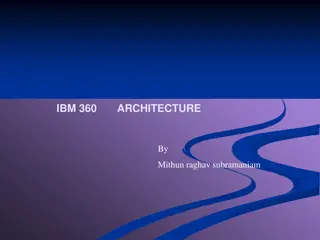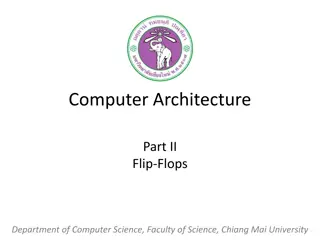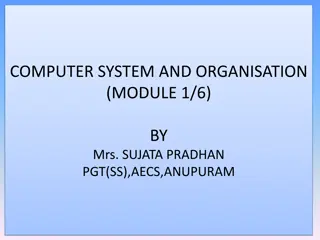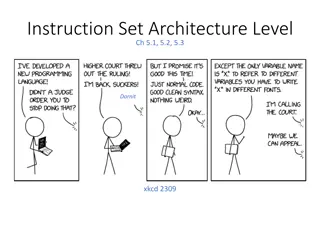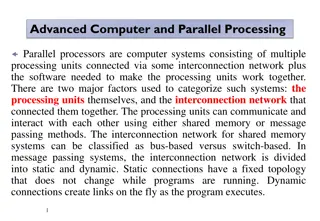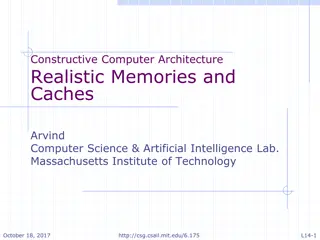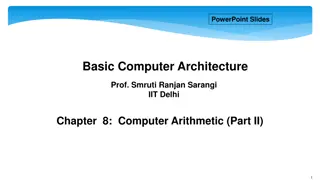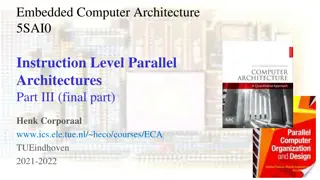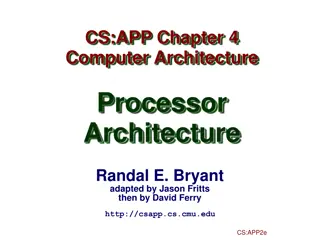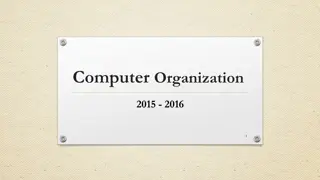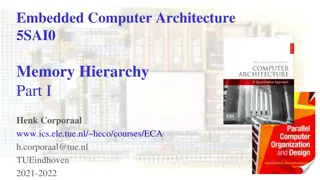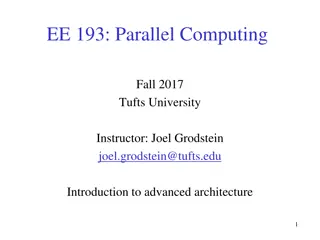Trends in Computer Organization and Architecture
This content delves into various aspects of computer organization and architecture, covering topics such as multicore computers, alternative chip organization, Intel hardware trends, processor trends, power consumption projections, and performance effects of multiple cores. It also discusses the scaling of database workloads on multiple-processor hardware and effective applications for multicore processors. The information provided sheds light on key design issues, technological advancements, and considerations for optimizing performance in modern computer systems.
Download Presentation

Please find below an Image/Link to download the presentation.
The content on the website is provided AS IS for your information and personal use only. It may not be sold, licensed, or shared on other websites without obtaining consent from the author.If you encounter any issues during the download, it is possible that the publisher has removed the file from their server.
You are allowed to download the files provided on this website for personal or commercial use, subject to the condition that they are used lawfully. All files are the property of their respective owners.
The content on the website is provided AS IS for your information and personal use only. It may not be sold, licensed, or shared on other websites without obtaining consent from the author.
E N D
Presentation Transcript
+ William Stallings Computer Organization and Architecture 9thEdition
+ Chapter 18 Multicore Computers
+ Alternative Chip Organization
+ Intel Hardware Trends
Power Memory +
+Power Consumption By 2015 we can expect to see microprocessor chips with about 100 billion transistors on a 300 mm2 die Assuming that about 50-60% of the chip area is devoted to memory, the chip will support cache memory of about 100 MB and leave over 1 billion transistors available for logic How to use all those logic transistors is a key design issue Pollack s Rule States that performance increase is roughly proportional to square root of increase in complexity
+ Performance Effect of Multiple Cores
Scaling of Database Workloads on Multiple-Processor Hardware
+ Effective Applications for Multicore Processors Multi-threaded native applications Characterized by having a small number of highly threaded processes Lotus Domino, Siebel CRM (Customer Relationship Manager) Multi-process applications Characterized by the presence of many single-threaded processes Oracle, SAP, PeopleSoft Java applications Java Virtual Machine is a multi-threaded process that provides scheduling and memory management for Java applications Sun s Java Application Server, BEA s Weblogic, IBM Websphere, Tomcat Multi-instance applications One application running multiple times If multiple application instances require some degree of isolation, virtualization technology can be used to provide each of them with its own separate and secure environment
+ Hybrid Threading for Rendering Module
Multicore Organization Alternatives
+ Intel Core Duo Block Diagram
+Intel x86 Multicore Organization Core Duo Advanced Programmable Interrupt Controller (APIC) Provides inter-processor interrupts which allow any process to interrupt any other processor or set of processors Accepts I/O interrupts and routes these to the appropriate core Includes a timer which can be set by the OS to generate an interrupt to the local core Power management logic Responsible for reducing power consumption when possible, thus increasing battery life for mobile platforms Monitors thermal conditions and CPU activity and adjusts voltage levels and power consumption appropriately Includes an advanced power-gating capability that allows for an ultra fine grained logic control that turns on individual processor logic subsystems only if and when they are needed Continued . . .
+Intel x86 Multicore Organization Core Duo 2MB shared L2 cache Cache logic allows for a dynamic allocation of cache space based on current core needs MESI support for L1 caches Extended to support multiple Core Duo in SMP L2 cache controller allows the system to distinguish between a situation in which data are shared by the two local cores, and a situation in which the data are shared by one or more caches on the die as well as by an agent on the external bus Bus interface Connects to the external bus, known as the Front Side Bus, which connects to main memory, I/O controllers, and other processor chips
+ Table 18.1 Cache Latency
Table 18.2 ARM11 MPCore Configurable Options
+ ARM11 MPCore Processor Block Diagram
+Interrupt Handling Distributed Interrupt Controller (DIC) collates interrupts from a large number of sources It provides: Masking of interrupts Prioritization of the interrupts Distribution of the interrupts to the target MP11 CPUs Tracking status of interrupts Generation of interrupts by software Is a single function unit that is placed in the system alongside MP11 CPUs Memory mapped Accessed by CPUs via private interface through SCU Provides a means of routing an interrupt request to a single CPU or multiple CPUs, as required Provide a means of interprocessor communication so that a thread on one CPU can cause activity by a thread on another CPU
+DIC Routing The DIC can route an interrupt to one or more CPUs in the following three ways: An interrupt can be directed to a specific processor only An interrupt can be directed to a defined group of processors An interrupt can be directed to all processors OS can generate interrupt to: All but self Self Other specific CPU Typically combined with shared memory for inter-process communication 16 interrupt IDs available for inter-processor communication
Interrupt States From the point of view of an MP11 CPU, an interrupt can be: Inactive Is one that is nonasserted, or which in a multi- processing environment has been completely processed by that CPU but can still be either Pending or Active in some of the CPUs to which it is targeted, and so might not have been cleared at the interrupt source Pending Is one that has been asserted, and for which processing has not started on that CPU Active Is one that has been started on that CPU, but processing is not complete An Active interrupt can be pre-empted when a new interrupt of higher priority interrupts MP11 CPU interrupt processing
+ Interrupt Sources Inter-process Interrupts (IPI) Private to CPU ID0-ID15 Software triggered Priority depends on target CPU not source Private timer and/or watchdog interrupt ID29 and ID30 Legacy FIQ line Legacy FIQ pin, per CPU, bypasses interrupt distributor Directly drives interrupts to CPU Hardware Triggered by programmable events on associated interrupt lines Up to 224 lines Start at ID32
ARM11 MPCore Interrupt Distributor
+Cache Coherency Snoop Control Unit (SCU) resolves most shared data bottleneck issues L1 cache coherency scheme is based on the MESI protocol Direct Data Intervention (DDI) Enables copying clean data between L1 caches without accessing external memory Reduces read after write from L1 to L2 Can resolve local L1 miss from remote L1 rather than L2 Duplicated tag RAMs Cache tags implemented as separate block of RAM Same length as number of lines in cache Duplicates used by SCU to check data availability before sending coherency commands Only send to CPUs that must update coherent data cache Migratory lines Allows moving dirty data between CPUs without writing to L2 and reading back from external memory
+ IBM z196 Processor Node Structure
+Summary Multicore Computers Chapter 18 Multicore organization Intel x86 multicore organization Intel Core Duo Intel Core i7-990X Hardware performance issues Increase in parallelism and complexity Power consumption ARM11 MPCore Interrupt handling Cache coherency Software performance issues Software on multicore Valve game software example IBM zEnterprise mainframe










![❤Book⚡[PDF]✔ The Apollo Guidance Computer: Architecture and Operation (Springer](/thumb/21611/book-pdf-the-apollo-guidance-computer-architecture-and-operation-springer.jpg)


